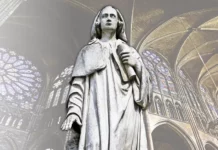The beginning of Lent is marked by a simple, but deeply symbolic ritual: the imposition of ashes as a sign of true and heartfelt repentance.
As we have already seen on previous occasions, the rich Liturgy of the Church wisely guides us throughout the year so that we can derive a specific spiritual benefit from each event. One of the times in which this occurs with greater intensity is the Lenten Season, “the acceptable time” for conversion (cf. 2 Cor 6:2).{/Normal CAP}
Throughout its six weeks of duration, grace prompts us to a sincere change of heart. Fasting, prayer and almsgiving are sensible signs of penance by which we prepare ourselves to commemorate the central event of Salvation History: the Resurrection of the Lord celebrated on Easter Sunday.
A unique and touching rite
Lent begins on Ash Wednesday, commemorated this year on February 13. The readings of the Holy Mass for this day were chosen by the Church with the goal of situating the faithful within the perspective of the time that is beginning. The prophecy of Joel convokes the people of Israel to penance as a means of calling down the mercy of the Lord (Jl 2:12-18). After the verses of the Miserere, the penitential psalm par excellence (Ps 51), the Apostle invites us to reconciliation with God (2 Cor 5:20; 6:2). Then, in the Gospel, Our Lord teaches us the true meaning of the prayer, fasting and almsgiving (Mt 6:1-6,16-18) which we will practice during this period.
After the Liturgy of the Word, the faithful participate in a unique and touching rite. Ashes are blessed by the priest and each person present comes forward to receive them in the form of a cross upon the forehead, retaining the mark of Christ on their brow for the rest of the day.
What is the origin and meaning of this ceremonial? This is what we will now examine.

Ashes as a sign of penance
An eloquent symbol of human frailty and the futility of worldly goods, ashes have been, from ancient times, a sign of struggle and suffering, even outside the ambit of the Chosen People. Thus, they symbolized the humiliation or the penance of man before God. The pages of Sacred History are filled with episodes in which the Israelites used ashes to acknowledge the nothingness of human nature in face of the designs of the Most High, before asking the aid of divine omnipotence.
Thus, for example, when the impious Haman plotted to eliminate the Jewish people from the Persian Empire, Mordecai covered himself with ashes (cf. Est 4:1), while many other Israelites “lay in sackcloth and ashes” (Est 4:3). And, convinced by her uncle of the need to present herself before King Ahasuerus to beseech of him the revocation of the decree, Esther spent three days in fasting and prayer and “covered her head with ashes” (Est 14:2) in order to ask the help of God before meeting with the tyrant.
Many similar incidences can be found in the pages of the Old Testament. Daniel asks clemency from God for Israel in exile, “with fasting and sackcloth and ashes” (Dn 9:3); Job is humbled and repents “in dust and ashes” (Job 42:6); and the King of Nineveh, a pagan, moved by the preaching of the Prophet Jonas who announced the destruction of the city, “sat in ashes” (Jon 3:6) and did penance together with all his subjects, obtaining from God the abolition of the penalty decreed against them. And likewise with many others.
In the New Testament, it is Our Lord Jesus Christ Himself who shows the importance of ashes as a penitential element in reprimanding Chorazin and Bethsaida, saying that, “if the mighty works done in you had been done in Tyre and Sidon, they would have repented long ago in sackcloth and ashes” (Mt 11:21).
From the earliest times of Christianity
From the earliest times of the Era of Grace, Christians adopted this form of expressing contrition and sorrow, as many documents bear witness.1 And over time, the use of ashes was incorporated into the public penitential rite by means of which the Sacrament of Reconciliation was administered at the beginning of Lent.
In Rome, for example, it is told that this rite was celebrated by the seventh century, on the Wednesday prior to the first Sunday of Lent. In cases of serious and public sins, the confessor vested the penitent in ordinary sackcloth, which he covered with ashes, before expelling him from the temple with these words: “Memento homo quia pulvis es et in pulverem reverteris: age pænitentiam ut habeas vitam æternam — Remember man that thou art dust and unto dust thou shalt return; do penance so as to gain eternal life.”
Following this, the sinner departed for remote places—monasteries outside the city or, in some cases, his own home, where he would do penance throughout all of Lent, to be readmitted into the community only on Holy Thursday. 2

With the passage of time, the number of faithful spontaneously participating in these penitential rites increased as they showed an eagerness to receive the same ashes with which repentant sinners were covered, out of devotion. And when the gradual mitigation of the forms of public penance and the evolution of the Sacrament of Reconciliation toward its present form made this harsh disciplinary ceremony disappear, the rite of ashes, together with more rigorous fasting on this day, continued as a penitential expression for the beginning of Lent.
Thus, already in the eleventh century the imposition of ashes, previously reserved for public sinners, became obligatory for laity and clerics. 3
The imposition of ashes today
The conciliar liturgical reform inserted the ceremony of the imposition of ashes into the context of the Eucharistic Celebration of this day, although, in cases of necessity, it can be administered outside of Mass, during a Liturgy of the Word.
According to a custom begun in the twelfth century, 4 the ashes received by the faithful on this day are obtained from burned palms blessed on Palm Sunday of the preceding year. This further highlights the futility of earthly glory, volatile as ashes blown by the wind; as fleeting as the praises proffered to the Saviour upon His entry to Jerusalem, which were soon transformed into cries of condemnation.
When we come forward to receive the ashes, the priest traces upon our forehead the sign of our Redemption in a very visible manner, for we should not hide our Christian Faith before the world, nor should we feel ashamed to acknowledge our need for conversion. And, while the minister of God imposes the ashes, he proclaims one of these two biblical phrases: “Remember that you are dust, and to dust you shall return” (cf. Gn 3:19) or “Repent, and believe in the Gospel” (Mk 1:15).
The first recalls the frailty of our human nature, well symbolized by dust and ashes, the implacable destiny of our mortal bodies. With it, the Liturgy elevates our sights to eternity, strengthening in us the “conviction that nothing on this earth has value if it does not concern the supernatural life, and that we are here to store up eternal treasures, not those which are consumed by the earth.” 5
The second emphasizes the urgent need for true conversion, a summons that will be repeated to us frequently throughout the Lenten season.

A sacramental of great value
The ceremony of the blessing and imposition of ashes should not be seen only as a beautiful expression of faith which hearkens to ancient times. Much more than having symbolic and historical value, it is a sacramental by which the Holy Church intercedes before her Divine Spouse for the faithful who partake in this ceremony and beseeches for them graces of penance and conversion.
Therefore, when he blesses the ashes, the priest asks God to pour out His blessing upon those who will receive them so that “as they follow the Lenten observance, they may be worthy to come with minds made pure to celebrate the Paschal Mystery” 6 or “through a steadfast observance of Lent, gain pardon of sins and newness of life.” 7 We should be convinced that upon receiving the now sacred ashes on our forehead, God will fortify our good resolutions for this penitential season with His grace.
Just as ashes are a symbol of death, during the Lenten journey we will die to sin with Christ, and, cleansed from our faults, will resurrect with Him, strengthened for a new life of Grace, clearly symbolized by the rejuvenating waters with which we will be sprinkled during the Easter Vigil.
Let us draw greater profit from this powerful aid that God places within our reach, and let us not fear to make daring resolutions that will lead us to an effective change of life. This conviction should also stimulate us to make a careful examination of conscience with the aim of making a good Confession! With the Holy Church praying for us, the necessary help will not be lacking to arrive at the glorious day of the Resurrection of the Lord with a soul entirely cleansed and renewed. ◊







